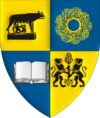- Dej
-
Dej — Municipality — Dej Calvinist Church 
Coat of armsLocation on Romania map Coordinates: 47°05′14″N 23°48′19″E / 47.08722°N 23.80528°ECoordinates: 47°05′14″N 23°48′19″E / 47.08722°N 23.80528°E Country  Romania
RomaniaCounty  Cluj
ClujStatus Municipality Government - Mayor Morar Costan (Social Democratic Party) Area - Total 109.12 km2 (42.1 sq mi) Population (July 1, 2007)[1] - Total 38,610 - Density 353.8/km2 (916.4/sq mi) Time zone EET (UTC+2) - Summer (DST) EEST (UTC+3) Website http://main.dej.ro/ Dej (Romanian pronunciation: [deʒ]; Hungarian: Dés; German: Desch, Burglos; Yiddish: דעעש) is a city in northwestern Romania, 60 km north of Cluj-Napoca, in Cluj County. It lies where the Someşul Mic River meets the river Someşul Mare River. The city administers four villages: Ocna Dejului, Peştera, Pintic and Şomcutu Mic.
The city lies at the crossroads of important railroads and highways linking it to Cluj-Napoca, Baia Mare, Satu Mare, Deda, Bistriţa, and Vatra Dornei.
Contents
Name
According to a legend, floating Hungarian tribes stopped for a rest at the place which would later be the location of the city. They were praying, and shouted "Deus" (God in Latin) three times. In fact, the name of the city is also the origin of the personal name, Des. The Romanian and German names of the city come from the Hungarian.
History
Dej is an old salt mining town built on a hilly ground. The first documents attesting the existence of this city go back to 1061 and 1214[citation needed]. Massive salt reserves were found in the area in Roman times. The Dej fortress was built sometime between 1214 and 1235.
King Andrew II of Hungary raised Dés to the privileged status of a free royal town. In 1241 the city was invaded by Tatars. The old mines were exhausted by 1717; the new mines are still in operation today. Some of the galleries of the salt mine are believed to be more than 15 kilometers long. The population of Dej used to consist mostly of Transylvanian Saxons, who settled here from Germany; their number decreased over centuries.
In 1638, Dej was the site for the show trial staged against the members of the Sabbatarians (Hungarian: Szombatosok), a sect formed during the Protestant movement; they were sentenced to death. The execution took place in Beszterce (Bistriţa).
In 1717, an attack by the Tatars of Crimea struck Dej.
From 1876 to 1920 Dej was capital of the Szolnok-Doboka County in the Kingdom of Hungary; from 1920 to 1940, capital of the Someş County in Romania.
Demographics
According to the last Romanian census from 2002 there were 38,437 people living within the city.
Of this population, 85.01% are ethnic Romanians, while 14.13 % are ethnic Hungarians and 0.9% others.[2]
Points of interest
The city's landmark is the Hungarian Reformed Church, built in the second half of the 15th century. The church displays Gothic elements carved in stone. The tower is 72 meters high, and the fortifying walls were erected in the 16th century, then torn down during a renovation in the 1880s. There is also a Franciscan monastery in Dej, which also has a large synagogue near the Reformed Church.
In 1944, the Jews of Dej, along with the Jews from the surrounding areas, were marched to the nearby bungar forest. Some 8,000 Jews were left exposed to the elements for approximately one month. In June 1944, the Jews were deported by train to Auschwitz for extermination. In 1944, the Jewish population accounted for approximately 25% of the entire city. In 2008, there are five Jews living in Dej. In front of the synagogue there is a memorial to the Jewish victims.
Other sites of interest in Dej: "Dr. Teodor Mihaly" and "Dr. Alexandru Vaida-Voevod" memorial houses and the Ocna Dej salt mine, said to be suited for the treatment of locomotor system diseases, asthenia, debility, and rachitis.
Gallery
References
- ^ "Population as of July 1, 2007" (in Romanian). INSSE. April 4, 2008. http://www.insse.ro/cms/rw/resource/populatia_stab_1%20iulie2007.htm. Retrieved 2008-05-04.
- ^ http://www.edrc.ro/recensamant.jsp?regiune_id=2140&judet_id=2295&localitate_id=2298
External links
Cluj County, Romania Cities Cluj-Napoca (county seat) · Câmpia Turzii · Dej · Gherla · Turda

Towns Communes Aghireşu · Aiton · Aluniş · Apahida · Aşchileu · Baciu · Băişoara · Beliş · Bobâlna · Bonţida · Borşa · Buza · Căianu · Călăraşi · Călăţele · Cămăraşu · Căpuşu Mare · Căşeiu · Cătina · Câţcău · Ceanu Mare · Chinteni · Chiuieşti · Ciucea · Ciurila · Cojocna · Corneşti · Cuzdrioara · Dăbâca · Feleacu · Fizeşu Gherlii · Floreşti · Frata · Gârbău · Geaca · Gilău · Iara · Iclod · Izvoru Crişului · Jichişu de Jos · Jucu · Luna · Măguri-Răcătău · Mănăstireni · Mărgău · Mărişel · Mica · Mihai Viteazu · Mintiu Gherlii · Mociu · Moldoveneşti · Negreni · Pălatca · Panticeu · Petreştii de Jos · Ploscoş · Poieni · Râşca · Recea-Cristur · Săcuieu · Sănduleşti · Săvădisla · Sâncraiu · Sânmartin · Sânpaul · Sic · Suatu · Tritenii de Jos · Tureni · Ţaga · Unguraş · Vad · Valea Ierii · Viişoara · Vultureni
Categories:- Populated places in Cluj County
- Cities in Romania
- Geography of Transylvania
Wikimedia Foundation. 2010.











